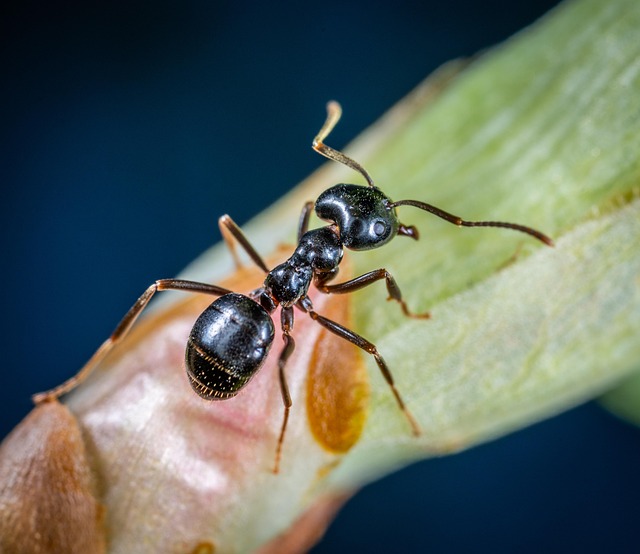Understanding ant behavior is key to effective ant control services, which employ specialized sugar-based baits mixed with insecticide. Modern technology has advanced baiting systems using smart sensors, GPS tracking, and data analytics for precise, efficient, and environmentally conscious pest management. These systems eliminate entire colonies by targeting specific species with slow-acting baits, reducing repopulation and the need for frequent treatments. Professional ant control services maintain these systems through strategic placement, daily monitoring, cleaning, and seasonal adjustments, alongside comprehensive pest management strategies for long-term effectiveness.
Ants, with their complex social structures, present a persistent challenge for pest control. To overcome this, advanced ant baiting systems offer a sophisticated approach to long-term management. This article delves into the science behind understanding ant behavior, exploring modern technologies that revolutionize ant control services. We’ll uncover effective strategies for sustainable ant management, providing practical insights on implementation and maintenance for continuous success in ant control services.
Understanding Ant Behavior: The Key to Effective Baiting
Understanding ant behavior is paramount in implementing effective ant baiting systems for long-term control, a service many ant control experts offer. Ants are highly organized social insects with distinct roles within their colonies, from workers gathering food to queens laying eggs. This complex structure means that simply eliminating visible ants may not solve the problem, as new ants can quickly replace them.
Ants also exhibit specific behaviors when searching for food and building nests, often following chemical trails left by their colony members. Baiting systems that take advantage of these behaviors are designed to introduce a toxicant into the ant population in a controlled manner. By offering a tasty bait, like a specialized sugar-based solution mixed with insecticide, ants carry this poison back to their nest, where it’s shared with the rest of the colony, ultimately leading to significant and sustained ant control.
Modern Technology in Ant Control Services: Advanced Baiting Systems
In the realm of ant control services, modern technology has revolutionized the way professionals manage and eliminate these persistent pests. One of the most significant advancements is the introduction of advanced baiting systems, designed for long-term control. These innovative solutions offer a more precise and effective approach compared to traditional methods. By employing cutting-edge science, bait stations are now equipped with smart sensors and targeted delivery systems, ensuring that ant baits are dispensed only where needed, minimizing environmental impact and maximizing efficiency.
The advanced baiting systems utilize modern technologies such as GPS tracking, remote monitoring, and data analytics to optimize the entire process. This allows pest control specialists to precisely locate ant infestations, monitor bait consumption, and adjust strategies accordingly. With real-time data at their fingertips, these professionals can ensure that ant populations are effectively reduced over an extended period, providing clients with long-lasting relief from these relentless intruders.
Long-Term Strategies for Sustainable Ant Management
Ants are relentless invaders, but with advanced baiting systems, long-term ant control is now more accessible than ever for both residential and commercial properties. These innovative strategies go beyond quick fixes by addressing the root causes of ant infestations, ensuring sustainable management. Professional ant control services employ tailored baiting techniques that target specific ant species while minimizing environmental impact.
By using slow-acting baits, ants carry the treatment back to their nests, eliminating colonies from within. This method prevents repopulation and requires fewer applications compared to traditional treatments. Moreover, these modern approaches focus on responsible pest management, reducing the use of harsh chemicals, and promoting a healthier ecosystem for both humans and local wildlife.
Implementation and Maintenance: Ensuring Continuous Ant Baiting Success
Successful implementation and ongoing maintenance are key factors in achieving long-term success with advanced ant baiting systems. These sophisticated systems, often employed by professional ant control services, offer a nuanced approach to managing ant populations effectively. The initial setup involves careful placement of baits, considering environmental factors and ant behavior to maximize coverage and attractivity. Regular monitoring is essential; checking baits daily ensures freshness and identifies any potential issues or changes in ant activity.
Maintenance includes keeping bait stations clean and well-stocked, as ants are fastidious creatures that prefer pristine resources. Seasonal adjustments may be necessary, such as altering bait types to align with changing ant species’ preferences. Additionally, maintaining a broader pest management strategy, including sealing entry points and removing potential food sources, reinforces the effectiveness of ant baiting systems over time.
Advanced ant baiting systems offer a sustainable solution for long-term ant control. By understanding ant behavior and leveraging modern technology, these innovative strategies provide an effective, eco-friendly approach to managing ant infestations. Implementing these systems requires careful planning and ongoing maintenance, but the benefits include reduced chemical usage and minimal environmental impact. For professional ant control services, adopting advanced baiting techniques is a game-changer, ensuring a quieter, pest-free environment for years to come.
